One of the more scenic segments of the Interstate system in California can be found on Interstate 5 from California State Route 151 in Shasta Lake City north through the Sacramento River Canyon to US Route 97 in Weed.
Thusly US 99 appears on the 1925 Rand McNally Map of California from Weed south to Redding.
The Marshall Plan was proposed in Congress in 1921 but was ultimately rejected as legislation due to the high costs. A less costly variation of the Marshall Plan was drafted by State Engineer Edward Hyatt in 1931 which was known as the State Water Plan. The State Water Plan was essentially the genesis of the Central Valley Project ("CVP") and California State Water Project ("CSWP"). The State of California intended to finance the CVP and CSWP sale of revenue bonds. The State authorized bonds for the CVP (which included Shasta Dam as a key piece) in 1933 but fell short of the funding required due to the Great Depression. The CVP was subsequently authorized in 1935 as one of the many New Deal public works projects.
Funding for the Central Valley Project along with it's potential benefits are outlined in the January 1932 California Highways & Public Works.
The March 1932 California Highways & Public Works makes reference to "Kennett Reservoir" as the modern name of "Shasta Lake" had not been yet adopted.
Kennett Dam and Reservoir appear as a conceptual illustration on the September 1933 California Highways & Public Works.
Coram and Kennett can be seen along the Sacramento River on the 1935 Division of Highways Map of Shasta County. In just a couple years the landscape around the confluence of the Sacramento River and Pit River would change forever.
Kennett Dam first appears as Shasta Dam in the October 1937 California Highways & Public Works.
In
November 1938 construction of a diversion tunnel at Shasta Dam began so
that the foundations could be built. The November 1939 California Highways & Public Works details the realignment of US 99/LRN 3 and the design of the new Pit River Bridge.
The October 1941 California Highways & Public Works goes on to state that grading for the realignment of US 99/LRN 3 above the Shasta Lake Reservoir was completed. The Pit River Bridge is shown only to have one span section not to have been installed. The article goes on further in noting that both the Pit River Bridge and the new alignment of US 99/LRN 3 were expected to be opened by Summer 1942. The unique dual rail/highway purpose of the Pit River Bridge is discussed and the earlier arch concrete 1915 Pit River Bridge can be seen the construction photos.
An older bridge over the Pit River can be seen in 1901 and is hosted on bridgehunter.com. This bridge was located upstream from the 1915 Pit River Bridge and was designed for wagon traffic.
Shasta Dam under construction during June of 1942.
Shasta Dam under construction in March 1943.
The newly completed Shasta Dam can be seen on the cover of the January/February 1946 California Highways & Public Works.
The same California Highways & Public Works issue details flood control measures at Shasta Dam.
The Federal Aid Highway Act was enacted on June 29th, 1956 which put US 99/LRN between Weed-Shasta Lake City on the planned route of I-5. The reconstruction of US 99/LRN 3 in the Sacramento River Canyon along with much of it's history as a transportation corridor is discussed in the May/June 1956 California Highways & Public Works. The first contract to rebuild US 99/LRN 3 in the Shasta River Canyon came in 1952 which was for 4 miles of divided highway north of Dunsmuir. This was followed by a new contract in 1953 to construct a new bridge over the Sacramento River in Dunsmuir. 12 miles of US 99/LRN 3 north from Redding to Shasta Lake City were cited to have been completed in 1955. The article goes on further in terms of describing three ongoing contracted projects in the Sacramento River Canyon which included a new bridge over Dog Creek and 6.5 miles of additional highway. Surveys for reconstructing the remaining 19 miles of US 99 between Shasta Lake and Dunsmuir were cited to be underway.
The May/June 1958 California Highways & Public Works cites that 6.9 miles of new divided highway for US 99/LRN 3 in the Sacramento River Canyon from near Lamoine to the vicinity of Shotgun Creek were under construction.
The 1966 Division of Highways State Map shows the planned bypass route for I-5 around downtown Weed.
Said I-5 bypass of Weed is shown complete on the 1967 Division of Highways State Map. The I-5 bypass of Weed would have functionally extended US 97 from downtown Weed to the new freeway alignment via former US 99 on South Weed Boulevard. What had been US 99 on North Weed Boulevard became CA 265. According to CAhighways.org US 97 was extended and CA 265 was created via 1965 Legislative Chapter 1402. I-5 south of Weed to Mount Shasta City is still shown to be an expressway.
A segment of I-5 between Delta and O'Brien appears upgraded to freeway standards on the 1969 Division of Highways State Map.
I-5 is shown as a freeway from Weed south to Mount Shasta on the 1975 Caltrans State Map.
Despite I-5 being functionally four lane fully in the Sacramento River Canyon segments remained expressway grade into the 1980s and 1990s. According to Scott Parker ("Sparker") of AAroads a segment of I-5 was upgraded to full freeway standards north the oxbow north of Vollmers in late 1987. This can be seen on the 1988 Caltrans State Map.
The final section of I-5 to be built to Interstate standards in the Sacramento River Canyon was the Vollmers-Castella segment in early 1992. According to Scott Parker said segment of I-5 was gradually built to Interstate standards over the course of six years.
In 2017 I-5 in the Sacramento River Canyon saw a minor improvement when the 1941 Antlers Bridge was replaced by a new bridge
Part 2; a drive on Interstate 5 north through the Sacramento River Canyon from Shasta Lake City to Weed
Our drive northbound I-5 through the Sacramento River Canyon begins at Exit 685 for CA 151 in Shasta Lake City. Traffic is advised that CA 151/Shasta Dam Boulevard accesses Shasta Dam. Cascade Boulevard is the historic alignment of US 99 through Shasta Lake City.
From CA 151 I-5 north is signed as 45 miles from Dunsmuir and 54 miles from Mount Shasta City.
I-5 north Exit 687 accesses Wonderland Boulevard, Old Oregon Trail, and Mountain Gate.
I-5 north Exit 689 accesses Wonderland Boulevard and Fawndale Road.
I-5 north Exit 690 accesses Bridge Bay Road.
I-5 northbound begins to approach the Shasta Lake Reservoir and crosses the Pit River Bridge. Upon crossing the Pit River Bridge I-5 north accesses Turntable Bay Road via Exit 692.
I-5 north of Exit 692 passes by a rest area. I-5 north Exit 695 accesses O'Brien, O'Brien Inlet Road, Packers Bay Road, and Shasta Caverns Road.
I-5 north Exit 698 accesses Gilman Road and Salt Creek Road.
North of Exit 698 Dunsmuir is signed as 32 miles away on I-5 north.
I-5 north crosses the new Antlers Bridge approaching Exit 702. Exit 702 accesses Lakehead, Lakeshore Drive, and Antlers Road.
I-5 north Exit 704 accesses Lakehead and Riverview Drive.
I-5 north leaves the boundaries of the Shasta Lake National Recreation Area. At Exit 707 I-5 north accesses; Vollmers, Delta, Dog Creek Road, and Delta Road.
I-5 north follows the Sacramento River towards Exit 710 for Lamoine and Slate Creek Road.
I-5 north Exit 712 accesses Pollard Flat.
I-5 north Exit 714 accesses Gibson Road.
From I-15 Exit 714 Dunsmuir is signed as 16 miles away.
I-5 north Exit 718 accesses Sims Road.
I-5 north Exit 720 accesses Flume Creek Road.
I-5 north Exit 721 accesses Conant Road.
I-5 north Exit 723 accesses Sweetbrier Avenue.
North of Exit 723 I-5 north has a vista of Mount Shasta.
I-5 north Exit 724 accesses Castella and Castle Crags State Park. Main Street is the original alignment of US 99 in Castella.
I-5 north Exit 726 accesses Soda Creek Road.
I-5 north Exit 727 accesses Crag View Road.
I-5 north Exit 726 accesses Crag View Road and Railroad Park Road.
I-5 north crosses the Siskiyou County Line and accesses Dunsmuir via Exit 729/Dunsmuir Avenue. Dunsmuir Avenue is the original alignment of US 99 in Munsmuir.
I-5 north Exit 730 also accesses Dunsmuir Avenue.
I-5 north Exit 732 accesses Dunsmuir Avenue and Siskiyou Avenue.
I-5 north Exit 734 accesses Mott Road.
I-5 north enters Mount Shasta City and accesses CA 89 at Exit 736.
I-5 north Exit 737 accesses Mount Shasta Boulevard. Mount Shasta Boulevard is signed as Historic US 99 and I-5 Business.
Weed is signed 9 miles from I-5 north Exit 737.
I-5 north Exit 738 accesses Lake Street and Lake Siskiyou.
I-5 north Exit 741 accesses Abrams Lake Road.
I-5 north Exit 743 accesses Summit Drive and Truck Village Drive.
I-5 north enters Weed and accesses Vista Drive at Exit 745.
I-5 north Exit 747 accesses US 97/Weed Boulevard. As noted above Weed Boulevard was the alignment of US 99.





















































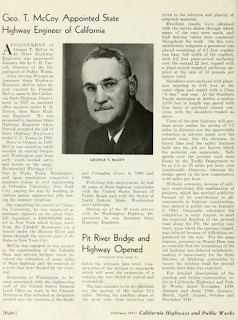











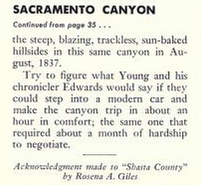




















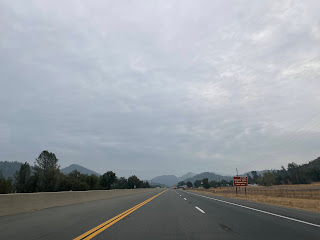






































































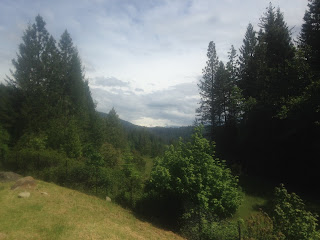






























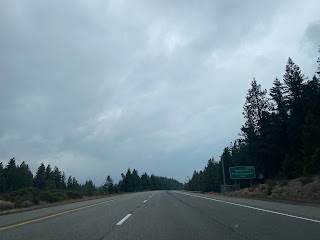





Comments